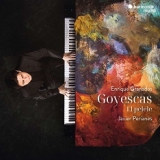Enrique Granados (1867-1916) schrieb seine Goyescas 1896 nach dem Besuch einer Goya-Ausstellung im Prado. Der Zyklus schildert Szenen aus dem Volksleben der Goya-Zeit. Javier Perianes gestaltet die einzelnen Stücke sehr farbig, mit einem satten Klavierklang, und skulptiert die Musik prägnant. Er kleidet die Musik von Granados in eine blendende, sinnliche, farbenfrohe, sehr virtuose Klaviersprache mit einem Hauch von Melancholie. Er kann mit der Leidenschaftlichkeit des Vortrags und einem überwältigenden Klavierklang die Aufmerksamkeit des Zuhörers ständig aufrechterhalten und ihm prallfarbige Bilder suggerieren. Bei aller Virtuosität und Sensibilität geht es Perianes vor allem um Sonorität und Gestik. Das zeichnet seine Aufnahme aus und unterscheidet sie (auch durch weniger Rubato und eine direktere Interpretation) von jener von Alicia de Larrocha
Gut, dass auch die Mikrophone diese Klanglichkeit wunderbar eingefangen haben und den ganzen Reichtum der Musik von Granados so opulent zum Klingen bringen. Insofern passt das Titelbild, wo man Goyas üppige Farben aus dem Klavier quellen sieht.
Enrique Granados (1867-1916) wrote his Goyescas in 1896 after visiting a Goya exhibition in the Prado. The cycle depicts scenes from popular life in Goya’s time. Javier Perianes creates the individual pieces very colorfully, with a rich piano sound and sculpts the music succinctly. He dresses Granados’ music in a dazzling, sensual, colorful, very virtuoso piano language with a touch of melancholy. With the passion of his performance and an overwhelming piano sound, he is able to constantly hold the listener’s attention and suggest colorful images. For all his virtuosity and sensitivity, Perianes is primarily concerned with sonority and gestures. This characterizes his recording and distinguishes it (also through less rubato and a more direct interpretation) from that of Alicia de Larrocha
It is good that the microphones have also captured this sonority wonderfully and bring out the full richness of Granados’ music so opulently. In this respect, the cover picture where you can see Goya’s lush colors spilling out of the piano is truly fitting.






















